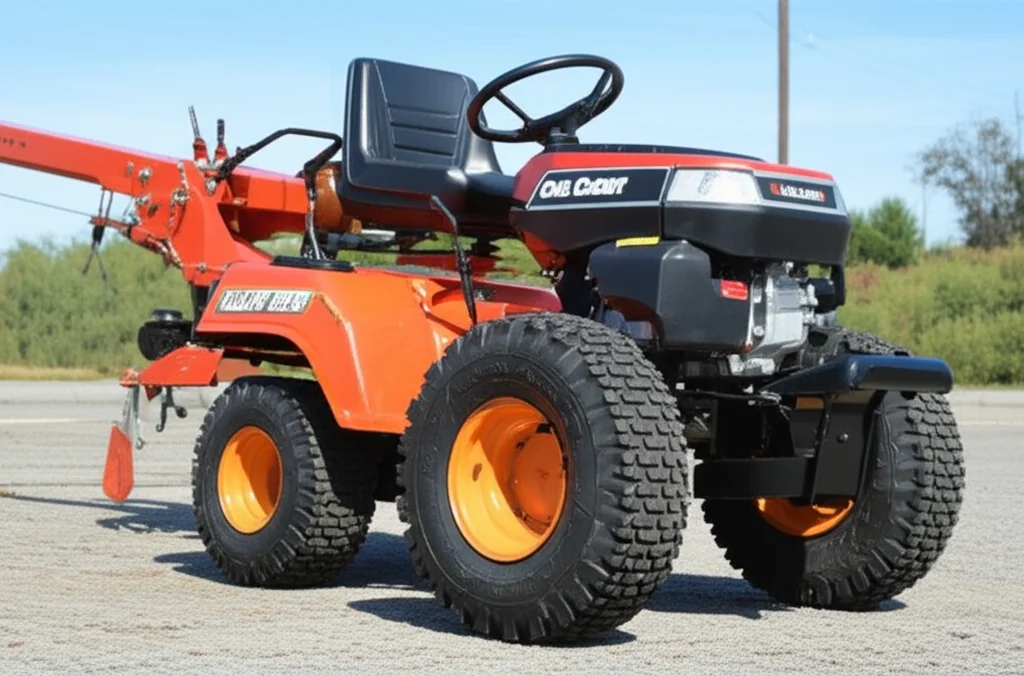· Lawn & Garden Equipment · 9 min read
Kawasaki Fr691v Cranks But Wont Start

Kawasaki FR691V Cranks But Won’t Start: Expert Solutions
When your Kawasaki FR691V engine cranks but won’t start, it can be incredibly frustrating, especially when you need to get your lawn work done.
This powerful 23-horsepower engine is known for its reliability, but like any mechanical system, it can develop starting issues over time.
Understanding why your engine is turning over but not starting is the first step toward getting back to work quickly and efficiently.
Key Takeaways
• Fuel system issues are the most common cause when your Kawasaki FR691V cranks but won’t start
• Check spark plugs first - they’re easy to inspect and often the culprit
• Clean or replace air filter to ensure proper airflow
• Verify fuel quality and replace old or contaminated gasoline
• Test ignition components including coils and safety switches
• Regular maintenance prevents most starting problems
Quick Answer
When your Kawasaki FR691V cranks but won’t start, the most likely causes are fuel delivery problems, faulty spark plugs, clogged air filter, or ignition system failures. Start by checking fuel quality, inspecting spark plugs, and ensuring the air filter is clean before moving to more complex diagnostics.
Understanding Your Kawasaki FR691V Starting System
The Kawasaki FR691V is a robust V-twin engine commonly found in commercial mowers and outdoor equipment. When this engine cranks but won’t start, it means the starter motor is functioning correctly, but the engine isn’t achieving combustion. This narrows down the potential issues significantly.
For successful engine operation, you need three essential elements: fuel, air, and spark. When any of these components fail or become compromised, your engine will crank endlessly without starting. The good news is that most starting issues with the FR691V are relatively straightforward to diagnose and fix.
Understanding your engine’s basic operation helps you troubleshoot more effectively. The FR691V uses a typical four-stroke cycle, requiring precise timing of fuel injection, air intake, compression, and exhaust. When troubleshooting why your Kawasaki lawn mower engine won’t start, systematic diagnosis saves time and prevents unnecessary parts replacement.
Fuel System Diagnosis and Solutions
Fuel-related problems account for approximately 70% of all starting issues in small engines. When your Kawasaki FR691V turns over but won’t start, begin with a thorough fuel system inspection.
Checking Fuel Quality and Flow
Start by examining the fuel in your tank. Old gasoline, contaminated fuel, or water infiltration can prevent proper combustion. Gasoline begins to degrade after 30 days, forming gums and varnishes that clog fuel system components. If your fuel smells stale or appears cloudy, drain the tank completely and refill with fresh gasoline.
Check fuel flow from the tank to the carburetor. Remove the fuel line at the carburetor and turn the fuel valve on (if equipped). Fuel should flow steadily without restriction. Weak or intermittent flow indicates a clogged fuel filter, blocked fuel line, or faulty fuel pump.
Carburetor Problems and Solutions
The carburetor is often the culprit when dealing with Kawasaki FR691V carburetor problems. Over time, fuel residue builds up in the carburetor’s small passages, preventing proper fuel delivery.
Common carburetor issues include:
- Clogged main jet or pilot jet
- Stuck float or needle valve
- Dirty fuel bowl
- Gummed-up passages
Clean the carburetor thoroughly using carburetor cleaner and compressed air. Pay special attention to the jets and small passages. If cleaning doesn’t resolve the issue, carburetor rebuilding or replacement may be necessary.
Ignition System Troubleshooting
A properly functioning ignition system is crucial for engine startup. When your engine cranks but won’t start, ignition problems are the second most common cause after fuel issues.
Spark Plug Inspection and Replacement
Begin by removing and inspecting the spark plugs. The Kawasaki FR691V uses two spark plugs, and both must function correctly for proper engine operation. Look for signs of fouling, carbon buildup, or electrode wear.
The spark plug gap for a Kawasaki FR691V engine should be set to 0.030 inches (0.76mm). Use a feeler gauge to verify proper gap spacing. Replace spark plugs that show excessive wear, cracked insulators, or heavy carbon deposits.
Test spark strength by grounding the spark plug against the engine block while cranking. You should see a strong, blue spark. Weak or absent spark indicates ignition coil problems or other electrical issues.
Ignition Coil Testing
Faulty ignition coils prevent spark plug firing, leaving you with an engine that cranks but won’t start. Test ignition coil resistance using a multimeter. Primary resistance should typically measure 0.2-0.5 ohms, while secondary resistance should read 10,000-15,000 ohms. Consult your service manual for exact specifications.
Replace ignition coils that test outside specified ranges or show signs of physical damage such as cracked housings or corroded connections.
Air Intake System Problems
Proper airflow is essential for combustion. A clogged air filter or blocked air intake can prevent your Kawasaki FR691V from starting, even with good fuel and spark.
Air Filter Maintenance
Remove and inspect the air filter element. Paper filters should be replaced when dirty or damaged, while foam filters can often be cleaned and reused. A severely clogged air filter restricts airflow, creating an overly rich fuel mixture that prevents starting.
Clean foam filters with warm, soapy water, rinse thoroughly, and allow to dry completely before re-oiling with clean engine oil. Paper filters should be replaced rather than cleaned to ensure optimal performance.
Intake System Inspection
Check for loose or damaged air intake components. Cracked intake manifolds, loose clamps, or damaged gaskets can cause air leaks that disrupt the proper air-fuel mixture. Even small air leaks can prevent starting or cause rough engine operation.
Safety Switch and Electrical Issues
Modern lawn equipment includes multiple safety switches that can prevent engine starting. These switches protect operators but can cause starting problems when they malfunction.
Common Safety Switch Problems
The Kawasaki FR691V may be equipped with several safety switches:
- Seat safety switch (on riding mowers)
- Blade engagement switch
- Parking brake switch
- Neutral safety switch (on zero-turn mowers)
A faulty safety switch can prevent the ignition system from receiving power, leaving you with an engine that cranks but won’t start. Test each switch for proper operation and continuity using a multimeter.
Electrical System Diagnosis
Check all electrical connections for corrosion, looseness, or damage. Pay particular attention to ground connections, as poor grounding can cause intermittent electrical problems. Clean corroded connections with electrical contact cleaner and apply dielectric grease to prevent future corrosion.
Battery voltage should measure at least 12.6 volts with the engine off. Low battery voltage can cause weak spark or prevent electronic fuel injection systems from operating properly.
Advanced Troubleshooting Techniques
When basic troubleshooting doesn’t resolve your starting problem, more advanced diagnostic techniques may be necessary.
Compression Testing
Low engine compression can prevent starting even with good fuel, air, and spark. Perform a compression test on both cylinders using a compression gauge. Typical compression should be 100-120 PSI, with no more than 20% difference between cylinders.
Low compression indicates worn piston rings, damaged valves, or blown head gaskets. These problems typically require professional repair or engine rebuilding.
Timing Verification
Incorrect valve timing or ignition timing can prevent starting. While timing adjustment requires specialized tools and knowledge, you can check for obvious problems such as broken timing belts or damaged keyways on the crankshaft.
If you suspect timing problems, consult a qualified technician for proper diagnosis and repair. Similar issues can occur with other engines, as seen in Kawasaki Mule turns over but won’t start situations.
Preventive Maintenance Tips
Regular maintenance prevents most starting problems and extends engine life significantly.
Seasonal Maintenance Schedule
Implement a comprehensive maintenance schedule:
- Change engine oil every 50 hours or annually
- Replace air filter annually or more frequently in dusty conditions
- Replace spark plugs every 200 hours or every two years
- Clean and inspect fuel system components annually
- Check and adjust valve clearances as recommended
Fuel System Maintenance
Use fresh gasoline and add fuel stabilizer if equipment will sit unused for more than 30 days. Drain fuel systems completely before long-term storage to prevent fuel-related problems.
Consider upgrading to ethanol-free gasoline if available, as ethanol can cause fuel system problems over time. Regular fuel filter replacement also prevents contamination from reaching the carburetor.
When to Seek Professional Help
While many starting problems can be resolved with basic troubleshooting, some issues require professional diagnosis and repair.
Complex Engine Problems
Seek professional help for:
- Internal engine damage requiring disassembly
- Valve timing adjustment
- Electronic fuel injection problems
- Transmission or drivetrain issues
Professional technicians have specialized tools and experience necessary for complex repairs. Attempting advanced repairs without proper knowledge can cause additional damage and increase repair costs.
Cost-Benefit Analysis
Consider repair costs versus equipment age and value when making repair decisions. Sometimes investing in professional repair makes sense, while other times replacement may be more economical.
For additional troubleshooting guidance on similar engines, check out resources on Kawasaki lawn engine turns over but won’t start issues.
Frequently Asked Questions
What do you do if your engine cranks but won’t start? Start with basic checks: verify fuel quality and flow, inspect spark plugs for proper gap and condition, check air filter cleanliness, and test ignition system components. These cover the most common causes of starting problems in small engines.
What does it mean when a motorcycle cranks but won’t start? While this applies to motorcycles, the same principles apply to lawn equipment engines. Cranking without starting indicates the starter motor works, but combustion isn’t occurring due to fuel, air, or spark problems.
What is the problem with the Kawasaki mower engine? Kawasaki engines are generally reliable, but common problems include carburetor clogging from old fuel, spark plug fouling, air filter restrictions, and safety switch malfunctions. Regular maintenance prevents most issues.
What is the spark plug gap for a Kawasaki FR691V engine? The correct spark plug gap for a Kawasaki FR691V is 0.030 inches (0.76mm). Use a feeler gauge to verify and adjust gap spacing before installation.
Why won’t my lawn mower start after sitting all winter? Winter storage often causes fuel system problems. Old gasoline forms gums and varnishes that clog carburetor passages. Drain old fuel, replace with fresh gasoline, and clean the carburetor if necessary.
How do I know if my ignition coil is bad? Test ignition coil resistance with a multimeter. Primary resistance should measure 0.2-0.5 ohms, secondary resistance 10,000-15,000 ohms. Physical damage like cracking or corrosion also indicates coil failure.
Can a dirty air filter prevent starting? Yes, a severely clogged air filter restricts airflow, creating an overly rich fuel mixture that prevents combustion. Regular air filter maintenance is essential for proper engine operation and starting.
Final Words
Diagnosing why your Kawasaki FR691V cranks but won’t start doesn’t have to be overwhelming. By systematically checking fuel quality, spark plug condition, air filter cleanliness, and ignition system components, you can identify and resolve most starting problems quickly. Remember that regular maintenance prevents the majority of these issues from occurring in the first place.
Start with the simplest checks first - fuel quality, spark plugs, and air filter - before moving to more complex diagnostics.
This methodical approach saves time and prevents unnecessary parts replacement. When basic troubleshooting doesn’t solve the problem, don’t hesitate to consult a qualified technician who can perform advanced diagnostics and repairs safely.
Take action today by implementing a regular maintenance schedule and addressing any starting issues promptly. Your Kawasaki FR691V engine will reward you with years of reliable service when properly maintained and serviced.
- Kawasaki FR691V
- Small Engine Repair
- No Start Condition


